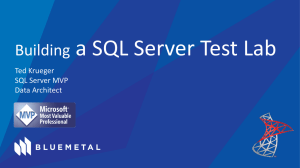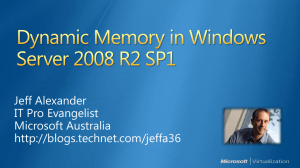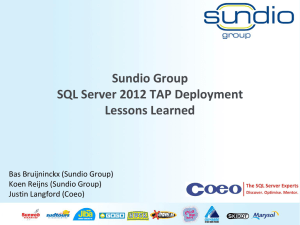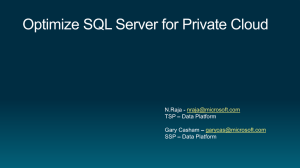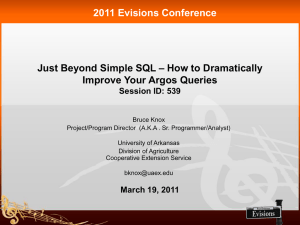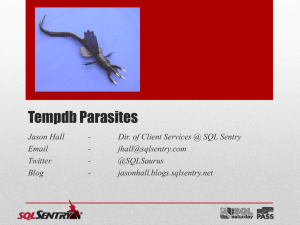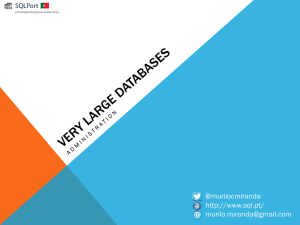Slides delivered for the Virtualization Strategies session
advertisement
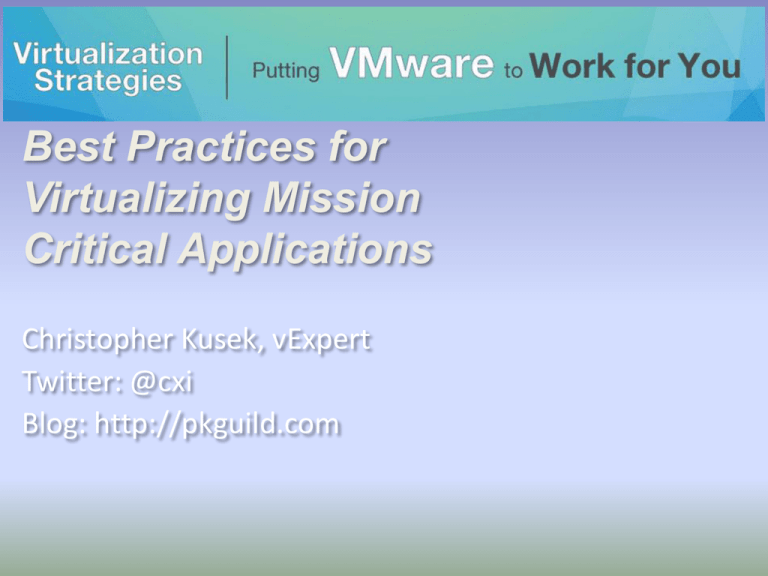
Best Practices for Virtualizing Mission Critical Applications Christopher Kusek, vExpert Twitter: @cxi Blog: http://pkguild.com Housekeeping • When tweeting about the sessions use # • Include commentary in this session to @cxi • Other housekeeping matters Virtualizing Tier 1 is Impossible Maturity begets virtualization 32-bit Windows 64-bit Windows 900MB Database Cache 32+ GB Database Cache 4Kb block size 8Kb block size High read/write ratio 1:1 read/write ratio *Not officially supported* 70% reduction in disk I/O 64-bit Windows 32Kb block size I/O pattern optimization I/O reduced 50% more Who ran first so I can run too? • United States Navy/Marine Corps – 750,000 mailboxes • University of Plymouth – 40,000 mailboxes • VMware IT – 9,000 very heavy mailboxes • University of Texas at Brownsville – 25,000 mailboxes • EMC IT – 53,000 mailboxes Where do I start? Virtual Exchange Start here • Refer to Support Policies, Recommendations and Best Practice Documents • Architect for the application, not for the virtualization solution • Pretend like you’re doing it physically… and Just do it virtually • Defaults unless requiring optimization! Start Simple • Deploy VMs with similar roles on separate hosts – MBX VMs in same DAG should not co-locate – Deploy with VMFS or Fixed Disk VHD – Scale up and scale out – Spread your CAS around Licensing Exchange in the Virtual!!! • One server license is required for each running instance of Exchange Server 2010 – whether it is installed natively on a physical machine or on a virtual machine • That’s pretty simple! Configure Storage • Review the Exchange Calculator to determine your memory, spindle and IOPS requirement • Configure your storage how you would handle it physically, then present it to your VMs • Size your MBX VHD or VMDK <2TB – Some suggest 2040GB to be on the safe side Configure Storage Continued • Array Snapshots for any virtualization vendor are not supported with Exchange Server – Support and supportability needs to be supplied by your storage vendor • Live Migration and vMotion are supported with Exchange Server, but not with DAGs* • Do exactly the same virtually as you would physically when it comes to allocation Configure Storage Continued • Take advantage of “Optimized for Virtualization” acceleration technologies by storage vendors – Storage Offloading (VAAI, ODX) – Per VHD / VMDK Locking • Unlike in the physical world, most data stores host more than one VM so account for that IO • Auto-tiering with small granularity (768k) can result in significant storage savings Exchange Best Practices • Do not P2V your Exchange Servers – Build new servers virtually and move mailboxes • Split your roles and size their CPU/Mem on a role by role basis • Analyze performance characteristics before and after if performing migration • Less physical servers != fewer resources Exchange Best Practices • Size Exchange VMs to fit within NUMA nodes for best performance • Do not over commit memory unless absolutely required • Consider DAG for local site HA, and SRM for site resiliency/DR • Virtual machine backup products that rely on virtual machine snapshots are not supported Get on the road to Virtual SQL Virtual SQL Start here • Refer to Support Policies, Recommendations and Best Practice Documents • Architect for the application, not for the virtualization solution • Pretend like you’re doing it physically… and Just do it virtually • Defaults unless requiring optimization! Start Simple • The average physical SQL Server uses 2 CPUs is 6% utilized, 3Gb Mem, 60% utilized, ~20 IOPS • Light workload? – Start with 2vCPUs, 3Gb ram • Heavy workload? – Start with 4vCPUs, 8Gb+ ram • Really Heavy workload? – Architect as if physical in the virtual – Use a capacity planner tool to assist Licensing SQL in the Virtual?!? • Standard, Workgroup, Enterprise per proc – You must license SQL for each virtual processor • Standard, Workgroup per Server/CAL – You must license each virtual operating system • Enterprise per physical proc – Licensing each physical processor entitles you to run any number of SQL server instances • 2012 switches to per core licensing! • Unsure? Contact licensing professionals! Virtualized SQL is blazing fast! Configure Storage Correctly • Database LUN needs enough spindles • Log LUN needs enough spindles • Mixing sequential (logs) and random (database) can result in random behavior – Avoid mixing workloads, refer to storage vendor • Fixed-size VHD or Eager-Zeroed Thick VMDK for your Database and Log volumes Configure Storage Continued • Array Snapshots for any virtualization vendor are not supported with SQL Server – Support and supportability needs to be supplied by your storage vendor • Live Migration and vMotion are supported with SQL Server • Do exactly the same virtually as you would physically when it comes to allocation Configure Storage Continued • Try to leverage Array Tiering and Acceleration technologies if possible – Use Array based caching to improve performance • Most DBs, even High IO ones are hot ~10-15% of the database, the rest is cold IO – Automatic Tiering makes for higher performance and higher efficiency while reducing cost Migrating SQL • • • • • Analyze your existing environment Perform a virtualization assessment Pay attention to disk spindles not total space Easy Migration: Use converter to clone server Easier mgmt and provisioning: Use Templates Database Best Practices • • • • • • • Follow Microsoft Best Practices for SQL Server Evaluate workloads for SQL-intensive ops Consider ScalingOut for high end deployments Defrag SQL Databases Design back-end to support workload (IOPS) Monitor DB/Logs for Disk r/w, Disk Queues Use Fibre-channel connectivity for storage Configuring Physical Files • Os/App, Data, Log and TempDB on separate spindles – Separate LUNs on single datastore will not provide IO separation • Use RAID10 or RAID5 (read-only) – Refer to your storage vendors best practices • Pre-size data files, do not AUTOGROW • Pre-size log files, ~10% of DB on average Configuring TempDB • • • • • • Move TempDB to dedicated LUN # of TempDB files = # of CPU cores All TempDB files should be equal in size Pre-Allocate TempDB space for workload Set file growth increment to minimize expand Microsoft recommends FILEGROWTH incr 10% SQL Failover Clustering Best Practices • Failover clustering is supported with caveats – Follow best practices guide for SQL Clustering – Use RDMS for DB and Log volumes – Use eagerthickzeroed disks – Use separate vSCSI controller for OS and Data – Use separate vSwitches for Public and Heartbeat – Team NICs for network redundancy SQL Failover Clustering Best Practices • SQL Database Mirroring (SQL 2008) or AlwaysOn Availability Groups (2012) can provide similar levels of availability as failover clusters but without the strict requirements or vendor support issues. • Most DBs have no failover capability not clustered. By making them virtual and letting them take advantage of vSphere HA (or the Hyper-V equivalent) adds availability not possible with physical servers General Best Practices • Best Practices for – Memory – CPU – Networking – Operations Memory is Key Memory Practices • Allocate your memory based upon your application workload • Database memory doesn’t dedupe well • Do not over subscribe mission critical workloads • Do NOT OVER SUBSCRIBE MISSION CRITICAL WORKLOADS – Use memory reservations for mission critical SQL workloads to avoid memory contention issues. VMware and Memory • Enable memory ballooning and memory page sharing • Do not over-commit memory • Set memory reserves to match VM config – Setting reservations could limit vMotion • Enable DRS* where supported • Avoid swapping by configuring VM with greater than average memory usage Can has more CPU CPU Practices • Only allocate vCPUs which are being used – Idle vCPUs will compete for system resources • If workload is unknown, size for fewer vCPUs – You can always add more later if reqs demand • For Performance Critical VMs – Try to ensure total number of vCPUs assigned to all VMs is <= total number of cores on the host – CPU load average of <=1. If greater, add more cpu FCoTR is the key to the future Networking Best Practices • Separate LiveMotion/vMotion, Logging and console traffic; or use VLAN tagging • Use a paravirtualized vNIC for high performance workloads • Leverage 802.1q using Virtual Switch Tagging (VST). - VST is most common configuration • Follow networking design guidelines • Do NOT use Jumbo Frames* Operations • Virtualizing Mission Critical Applications should leverage Virtualization monitoring solutions like – System Center – vCenter Operations Clusters • Microsoft does not support migration of running virtual machines running cluster software. – Caveat* Alignment • Ensure your VMs have their disks aligned – Boot alignment is auto in 2008, manual in 2003 – Application LUN is manual, follow application and storage vendor best practices Thank you! Links if you don’t see presenter notes! • • • • • Microsoft Support Policies and Recommendations for Exchange Servers in Hardware Virtualization Environments Exchange 2010 on VMware - Best Practices Guide http://www.vmware.com/pdf/Virtualizing_Exchange2003.pdf http://www.vmware.com/files/pdf/solutions/08Q4_VM_Exchange_Server_2007_VI3_WP.pdf http://www.vmware.com/files/pdf/Exchange_2010_on_VMware_-_Best_Practices_Guide.pdf • • • • Microsoft Virtualization Best Practices for Exchange HP recommended configuration for Exchange Server 2010 and Hyper-V R2 for 5,000 users Exchange Server 2007 and Hyper-V: Best Practices Blog Post Policies and Recommendations for Exchange Servers in Virtualization Environments • • • • Refer to these great blog series which covers Exchange and VMware http://www.clearpathsg.com/blogs/2010/07/13/exchange-2010-vsphere-4-best-practices-part-1 http://www.clearpathsg.com/blogs/2010/07/29/exchange-2010-vsphere-4-best-practices-part-2 http://www.clearpathsg.com/blogs/2011/01/13/exchange-2010-vsphere-4-best-practices-part-3 • • Duncan Epping http://www.yellow-bricks.com/2008/12/17/exchange-2007on-vmware/ • • • • • • • • Best Practices for SQL Server with VMware Microsoft SQL Server and VMware Virtual Infrastructure Best Practices Running SQL in a Hyper-V Environment Consolidation Guidance for SQL Server High Performance SQL Server Workloads on Hyper-V SQL Server 2008 on Hyper-V - Best Practices & Performance Licensing SQL Alignment Credits • Christopher Kusek, vExpert, CISSP, MCT • Twitter: @cxi • Blog: http://pkguild.com
